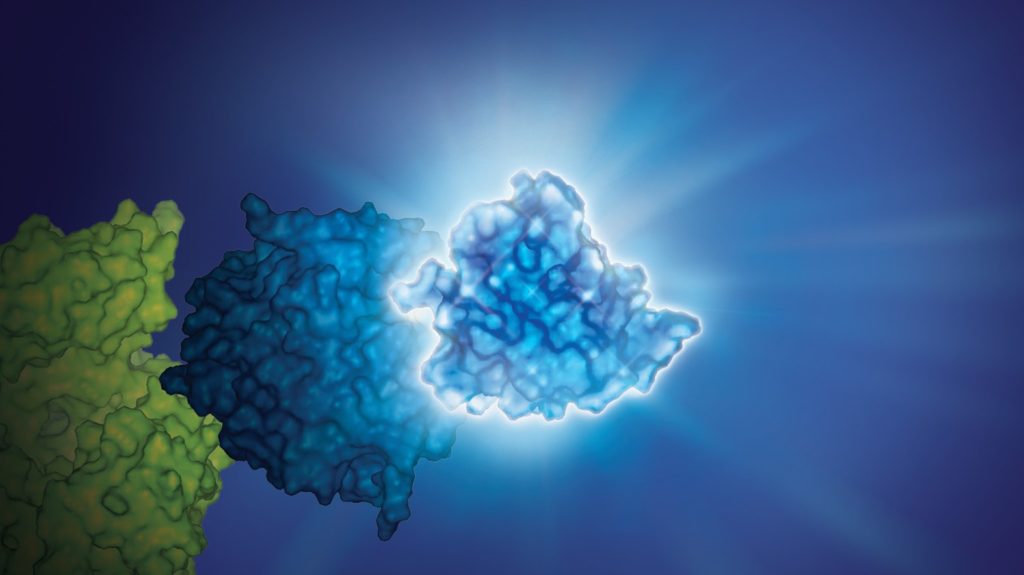
What can you do with a small, super bright luciferase? Amazing things. We’ve highlighted many of the papers and new applications that NanoLuc® luciferase has enabled on this blog. While NanoLuc® luciferase was first introduced as a reporter enzyme to assess promoter activity, its capabilities have expanded far beyond a genetic reporter, creating bioluminescent tools used to study endogeneous protein dynamics, target engagement, protein degradation, immunodetection and more. So where did the NanoLuc luciferase come from and how does one enzyme power so many research capabilities? Read further for a primer on the various technologies and applications developed from this enzyme over the last 10 years.
The story of NanoLuc® luciferase starts with a deep sea shrimp and its bioluminescent enzyme and substrate that were both evolved with some tinkering from Promega scientists. The result: A small 19kDa reporter enzyme with a luminescent signal 100X brighter than that of firefly or Renilla luciferase and with stable “glow-type:” kinetics. The small size and signal intensity of NanoLuc® luciferase provides a sensitive reporter that can be used not only in traditional genetic reporter assays but also can function as a protein fusion reporter. Furthermore, the small size of the engineered NanoLuc® luciferase means the enzyme can be used to create reporter viruses without disrupting packaging or measure endogenous expression using CRISPR-Cas9 gene editing. Read how NanoLuc® luciferase was developed in this article.
With such a bright enzyme and narrow emission spectrum, NanoLuc® luciferase makes an ideal luminescent donor for bioluminescence resonance energy transfer (BRET) assays that measure molecular proximity. We took it a step further and partnered NanoLuc® luciferase with the HaloTag® protein and its fluorescent ligands to create a NanoBRET™ protein:protein interaction (PPI) assay format. The bright, blue-shifted signal from the NanoLuc® donor combined with the far-red-shifted HaloTag® acceptor enables a live-cell, PPI assay with optimal spectral overlap, increased signal, and lower background compared to conventional BRET assays. This article describes how the NanoBRET™ PPI assay format was developed.
Not only can you measure protein:protein interactions, but NanoBRET™ technology also powers live-cell target engagement (TE) assays that measure how tightly a compound binds to a protein (compound affinity) and how much compound binds to the protein (target protein occupancy). You can even assess how long a protein binds to the target protein (residence time) under physiological conditions. Read how NanoBRET™ technology measures target engagement in live cells.
While energy transfer-based methods like BRET are one way to assess molecular interactions inside the cell, NanoLuc® luciferase was also adapted to complementation-based methods that rely on the interaction of enzymatic subunits to reconstitute the bright luminescent enzyme. NanoLuc® Binary Technology (NanoBiT®) is uses the Large BiT (LgBiT) subunit, an 18kDa protein that was optimized for stability and low enzymatic activity. Upon interaction of LgBiT with a small complementary peptide, an active enzyme is formed that generates a bright luminescent signal in the presence of substrate. For the study of protein:protein interactions, the complimentary peptide is Small BiT (SmBiT, 11 amino acid peptide), which has been optimized to have low affinity for LgBiT. The two subunits only form an enzyme when fused to target proteins and the two target proteins interact, bringing SmBiT and LgBiT together, enabling a sensitive method to assay protein association/disassociation kinetics using a simple bioluminescent signal. Learn how NanoBiT was developed in this ACS Chemical Biology article.
The SmBiT/LgBiT subunits of the NanoBiT® system have been further utilized to create bioluminescence-based detection of specific antigens or antibodies, referred to as Lumit™ Technology. In Lumit™ immunoassays, spearate antibodies are chemically labeled with SmBiT and LgBiT respectively. When the two antibodies come into proximity in the presence of analyte, the active enzyme is formed, and a bright luminescent signal is generated in the presence of substrate. Lumit™ assays have been developed in direct, indirect, and competitive binding formats for analyte detection. Read about how Lumit was used to develop immunoassays for the measurement of signaling pathway regulation.
NanoBiT® technology was further adapted to create a bioluminescent protein tagging system, by identifying an alternate small subunit that complements LgBiT with high affinity, HiBiT. The HiBiT peptide and LgBiT subunit interact spontaneously, providing sensitive bioluminescent detection of HiBiT-tagged proteins by adding purified LgBiT as part of the detection reagent. The 11-amino acid HiBiT tag can even be inserted into the endogenous locus using CRISPR-Cas9 gene editing for studying endogeneously expressed proteins using bioluminescent techniques. Read about using CRISPR with the HiBiT luminescent peptide. The HiBiT tag offers a quantitative and sensitive method for investigating protein abundances and dynamics. The resent addition of a highly specific Anti-HiBiT mAb, creates even more possibilities for detection of the HiBiT tag.
Want to learn more about NanoLuc® luciferase and its capabilities? Check out our NanoLuc® Luciferase technology page for additional resources and applications.
Related Posts
Sara Klink
Latest posts by Sara Klink (see all)
- A One-Two Punch to Knock Out HIV - September 28, 2021
- Toxicity Studies in Organoid Models: Developing an Alternative to Animal Testing - June 10, 2021
- Herd Immunity: What the Flock Are You Talking About? - May 10, 2021
